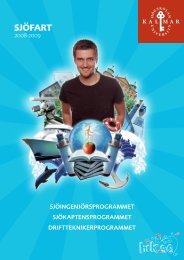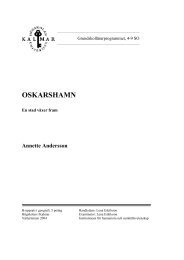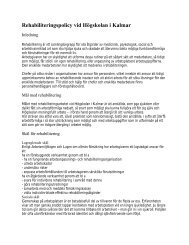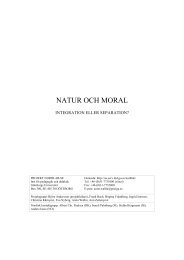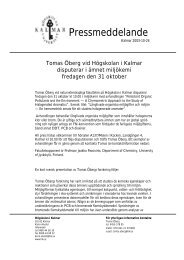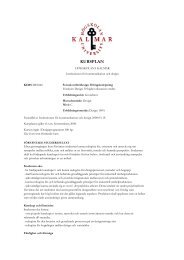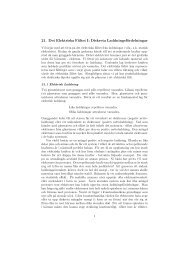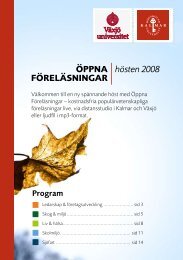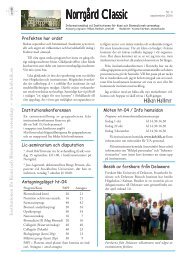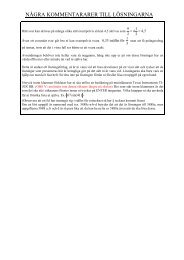The Landscape of Archaeology - Högskolan i Kalmar
The Landscape of Archaeology - Högskolan i Kalmar
The Landscape of Archaeology - Högskolan i Kalmar
Create successful ePaper yourself
Turn your PDF publications into a flip-book with our unique Google optimized e-Paper software.
<strong>The</strong> <strong>Landscape</strong> <strong>of</strong> <strong>Archaeology</strong><br />
Charlotte Fabech & Ulf Näsman<br />
<strong>Högskolan</strong> i <strong>Kalmar</strong>, Humanvetenskapliga institutionen
Relevant background<br />
Ulf: <strong>Archaeology</strong> at Uppsala with long tradition <strong>of</strong> landscape<br />
archaeology.<br />
<strong>The</strong> Stockholm tradition <strong>of</strong> historic agrarian geography.<br />
Charlotte: <strong>Archaeology</strong> at Aarhus with long tradition <strong>of</strong><br />
settlement archaeology.<br />
Historic-economic geography at Lund<br />
Result: <strong>The</strong> spatial studies <strong>of</strong> Swedish archaeology and historic<br />
geography met the strong Danish settlement archaeology at<br />
Aarhus in the 1980-90ies.
Research projects<br />
1993-1998 Settlement and landscape.<br />
1997-2001: the subproject Regionality in the cultural landscape<br />
at the research centre Changing landscapes.<br />
1998-2003: subproject <strong>The</strong> agrarian landscape: area use and<br />
regional variation in the Iron Age and Early Middle Ages<br />
in the project Agrar 2000, a part <strong>of</strong> the research programme<br />
<strong>The</strong> agrarian landscape in Denmark.
Landskap and bygd<br />
In old Nordic landskap means “the nature/character <strong>of</strong> nature” and became<br />
later used to signify an administrative unit (provincia) with fixed<br />
borders in the terrain.<br />
In old Swedish bygd is an old self-grown unit <strong>of</strong> sites, which are<br />
socially bound together and is surrounded by undefined<br />
borderlands.<br />
In Swedish landscape archaeology landskap is an analytical concept<br />
in the present, while “Bygd” is the man-made, settled landscape <strong>of</strong><br />
a social unit in the past = Det bebyggda landskapet.<br />
A special meaning in Swedish is: An old political-administrative unit,<br />
e.g. “Öland är ett litet landskap”.
<strong>The</strong> archaeological chronology in Sweden<br />
compared to the terminology in English and German archaeology.<br />
Periods considered prehistoric are in Italics. Periods considered to be historic are bolded.<br />
Note that the Late Iron Age in England ends at the Birth <strong>of</strong> Christ<br />
but in Sweden the concept is used for the period c. 400-1100 AD.<br />
Thus the periods <strong>of</strong> the yngre järnålder in Sweden correspond to the Early Middle Ages in England and to<br />
Frühmittelalter in Germany.<br />
500<br />
f.Kr.<br />
England Iron Age<br />
Early - Late<br />
Kr.f. 400/500<br />
e.Kr.<br />
Roman<br />
period<br />
Early Middle Ages/Dark<br />
Ages<br />
Germany Vorrömische Eisenzeit Römische Kaiserzeit Frühmittelalter<br />
Völkerwanderungs-zeit<br />
Merowingerzeit<br />
Sweden Äldre järnålder Yngre järnålder<br />
Förromersk järnålder Äldre Romersk järnålder<br />
Yngre romersk järnålder<br />
Folkvandringstid<br />
Vendeltid<br />
Vikingatid<br />
1000/1100 1500<br />
e.Kr.<br />
High Medieval period<br />
Late Medieval period<br />
Hochmittelalter<br />
Spätmittelalder<br />
Tidigmedeltid<br />
Högmedeltid<br />
Senmedeltid<br />
un 2002/7
<strong>Landscape</strong> archaeology<br />
<strong>Landscape</strong> archaeology is the spatial study <strong>of</strong> human interaction with other humans<br />
and with ”nature”.<br />
<strong>The</strong> archaeological landscape is primarily a social scene and the subsistence<br />
production is merely a backdrop.<br />
<strong>The</strong> landscape is a scene on which historical events “took place” and thus<br />
contributed to its mythical and mental dimensions.<br />
In this way landscape archaeology differs from traditional settlement archaeology<br />
(about dwelling sites and settlement pattern) and from agrarian history (about<br />
agriculture).<br />
It is not an understanding <strong>of</strong> the landscape in itself or the settlement in itself that is<br />
the aim.<br />
But it is the understanding <strong>of</strong> the people who made and lived in the landscape.<br />
This means that all archaeological sources are used and that a cross-disciplinary<br />
approach is used (collaboration with history, onomastics, relevant sciences,<br />
etc.).
Settlements = Hoards ++ Graves xx Stray finds Churches<br />
Red symbols are 4th-8th century.<br />
From:Thrane, Henrik 1987. Das Gudme-Problem und die Gudme--Untersuchung.<br />
Frühmittelalterliche Studien 21, 1987: 1-48 & Taf. 1-16.
Brink, Stefan 2004. Mytologiska rum och eskatologiska föreställningar i det vikingatida Norden.<br />
In: Andrén, Anders et al. (ed.) Ordning mot kaos. (Vägar till Midgård 4): 291-316.
<strong>Landscape</strong> archaeology<br />
Chronological perspective:<br />
synchronic diachronic<br />
evolutionary teleological<br />
retrogressive<br />
Spatial perspective:<br />
global from satellite<br />
superregional from aircraft<br />
regional from helicopter<br />
local from ladder
<strong>The</strong> famous Dejberg wagons were found<br />
in a bog.<br />
<strong>The</strong>y date to the pre-Roman Iron Age.<br />
An excavated hall in a settlement is<br />
from the Migration period.<br />
Viking Age settlement finds are made<br />
as well. But the settlement is not excavated.<br />
<strong>The</strong> standing church was built in<br />
the High Middle Ages.<br />
<strong>The</strong> manor was also high medieval<br />
but has since been discontinued.<br />
From:<br />
Fabech, Charlotte 1997. Slöinge i perspektiv. In:<br />
J. Callmer & E. Rosengren. (eds) "... gick Grendel<br />
att söka det höga huset..." Arkeologiska källor till<br />
aristokratiska miljöer i Skandinavien under<br />
yngre järnalder. Halmstad: 145-160.
Sources <strong>of</strong> multidisciplinary landscape<br />
studies<br />
Scientific Historical Archaeological<br />
Geography Texts Graves<br />
Geology Maps Hoards<br />
Botany Place names Settlements<br />
Pedology Historic settlement<br />
pattern<br />
Stray finds<br />
= Oral tradition Traces <strong>of</strong> infrastructure<br />
Natural topography Historic topography Archaeological<br />
topography
Lolland<br />
One <strong>of</strong> the maps<br />
produced by<br />
Videnskabernes<br />
Selskab ca 1800.<br />
<strong>The</strong> percentage <strong>of</strong> forest<br />
per parish based on the<br />
maps <strong>of</strong> Videnskabernes<br />
Selskab.<br />
Falster<br />
<strong>The</strong> maps <strong>of</strong> Videnskabernes selskab show the forests in<br />
Denmark ca 1800 A.D.<br />
<strong>The</strong> distribution corresponds well to the relation between<br />
open land and forests in the Viking Age as illustrated by<br />
pie charts <strong>of</strong> pollen analyses.<br />
After Bent Aaby.
Map <strong>of</strong> bygder in SW Sweden (Halland and Västergötland)<br />
based on the archaeological record and geography.<br />
Dots are find spots <strong>of</strong> Migration period gold finds.<br />
Stars are the famous gold neck-rings from Köinge, Möne<br />
and Ålleberg.<br />
From:<br />
Fabech, Charlotte 1997. Slöinge i perspektiv. In:<br />
J. Callmer & E. Rosengren. (eds) "... gick Grendel<br />
att söka det höga huset..." Arkeologiska källor till<br />
aristokratiska miljöer i Skandinavien under<br />
yngre järnalder. Halmstad: 145-160.
Finnestorp<br />
<br />
Rich finds and place names reveal<br />
that Falbygden in the Migration<br />
period was a central part <strong>of</strong><br />
Västergötland
Various landscapes in recent literature<br />
Natural landscape Cultural landscape Agrarian landscape<br />
Meaning landscape Bronze Age landscape Danish landscape<br />
Halland landscape Manorial landscape Heath landscape<br />
Historic landscape Ideological landscape Industrial landscape<br />
Iron Age landscape Maritime landscape <strong>Landscape</strong> <strong>of</strong> power<br />
Medieval landscape Mental landscape Commemorative<br />
landscape<br />
Modern landscape Nordic landscape Norwegian landscape<br />
Cultivated landscape Invisible landscape Ornamental landscape<br />
Political landscape Forested landscape Plain landscape<br />
Social landscape Stone Age landscape Sacral landscape<br />
Swedish landscape Traditional landscape Urban landscape
Spatial hierarchies in the social<br />
Territory: Farm<br />
Horizontal<br />
Social<br />
space:<br />
Vertical<br />
Social<br />
space:<br />
Political<br />
space:<br />
Gård<br />
Family<br />
Familj<br />
Thrall<br />
Träl<br />
Head <strong>of</strong><br />
family<br />
Familjeöverhuvud<br />
landscape<br />
Village<br />
By<br />
Family line<br />
Ätt<br />
Free<br />
Fri<br />
Village<br />
community<br />
Byråd<br />
Settlement<br />
area<br />
Bygd<br />
Clan<br />
Klan<br />
High-born<br />
Högättad<br />
Thing<br />
Ting<br />
Chiefdom<br />
Hövdingadöme<br />
Tribe<br />
Stam<br />
Princely<br />
family<br />
Furstesläkt<br />
Tribal thing<br />
Stamting<br />
Kingdom<br />
Kungadöme<br />
Realm<br />
Rike<br />
Royal<br />
family<br />
Kungasläkt<br />
Council <strong>of</strong><br />
the realm<br />
Riksråd
From: Herschend, Frands 1994. Models <strong>of</strong> petty rulership: two early settlements in Iceland. Tor 26: 163-191.<br />
Skalagrim was a chieftain, who was<br />
expelled from Norway and settled in<br />
Iceland in the 9th century.<br />
His settlement in Iceland was an ideal<br />
landnam reflecting a Scandinavian way <strong>of</strong><br />
thinking about settlement organisation.<br />
Borg was the seat <strong>of</strong> Skalagrim.<br />
Grim was his foremost shipmate, who<br />
was given a site opposite Borg.<br />
Olaf and Yngvar were important men<br />
invited to settle near Skalagrim.<br />
Six free shipmates were each granted a<br />
farm near Borg.<br />
Two secondary farms were established<br />
further away.<br />
Five production units belonged to Borg<br />
(stockbreeding, salmon fishing, hunting,<br />
iron production).




